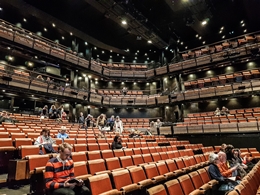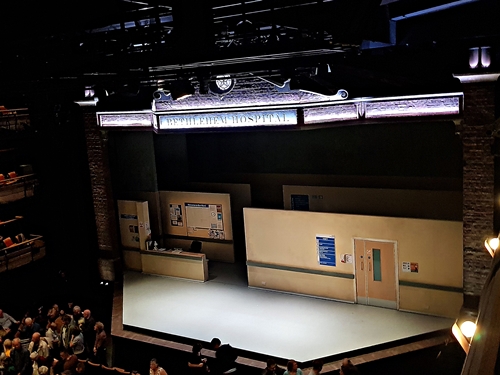
People enter keenly
The auditorium fills
Let the show begin
Auditorium of the Bridge Theatre, London


People enter keenly
The auditorium fills
Let the show begin
Auditorium of the Bridge Theatre, London

In the past, I preferred watching films (‘movies’) to attending live drama at the theatre. Now, my preferences have reversed. In live theatre there is an interraction between the actors on stage and the audience. Good actors engage the audience psychologically and almost physically. And, I suspect that the actors are also engaged by the audience – its attentiveness, its reactions (facial and otherwise), and other signs of the audience’s feelings provoked by their actions. So great is that interaction between performers and the audience that often I leave the theatre at the end of a performance feeling physically exhausted. Even with superb cinema productions, I never feel as gripped by the performance as I do whilst watching live theatre.
Having stated the above, I am now going to be a bit critical. I have watched many live performances of drama on stage, much of which was excellent. However, I have noticed that in some plays, the first (opening) act is often very weak compared with what follows later. On several occasions, I have walked out of the theatre because a play’s first act or first half has been unpromising. This is sad because now I know that many plays improve as they progress.
I cannot understand why so many plays have weak opening scenes. If I were reading a book and the first 10 or 20% of its pages did not capture my attention, I would abandon the idea of reading it through to its end. Why do so many people remain in the theatre when the opening act is unpromising? Is it because they have paid so much for the tickets? Or, is it because they, like me, have realised that most plays take time to build up to an engaging/enjoyable momentum?
Recently, I saw a play “Amsterdam” by Mayur Arad Yasur at the Orange Tree Theatre at Richmond (SW London). From its first moment, neither the actors nor the play were able to engage me. The same seemed to be the case for several other members of the audience, who walked across the stage and out of the auditorium within a few minutes of the play’s beginning.
Mercifully, about half way through the performance, which did nothing to make me forget the discomfort caused by my seat – it did the opposite, there was a technical hitch. The performance was paused, and some member of the theatre staff mumbled something, which I imagine was to notify us of the hitch. After almost 10 minutes during which no further information was given to the by now restive audience, I decided to follow the actors backstage to find out what was going on. Only then, did someone come out on to the stage to give some information. As what we had already seen of the play had been so unbearable and there seemed to be no sign that the performance would be resumed in the near future, we walked out. Had the play been more enjoyable or in some way worthwhile, we would have waited for it to continue.
Well, you cannot win every time. For each disaster such as “Amsterdam”, we have have seen plenty of highly satisfactory plays.

All the world is a stage
we play our unique parts
and then take our leave
On Saturday the 29th September 2018, we had a wonderful evening at London’s recently opened Bridge Theatre. It is located on the south bank of the River Thames, a stone’s throw from the world famous ‘icon’ of London, Tower Bridge. From the glass front of the theatre’s foyer, there are superb views of: the new high-rise buildings in the City (including the ‘Gherkin’); the White Tower and the walls of the Tower of London; and Tower Bridge, which is beautifully illuminated at night.

The Bridge Theatre opened for its first show in October 2017. The theatre is the brainchild of Nick Starr, of the former National Theatre, and the renowned theatre director Nicholas Hytner. Both of these two Nicks have been long involved with London’s National Theatre. Their creation, the Bridge, is an improved version of the facilities offered by the now ageing National Theatre on the Southbank. Excellent as the National Theatre is, the Bridge seems to have been designed to avoid some of the defects of the former. The newer theatre, which can seat 900 audience members, was designed by S Tompkins and R Watts of Haworth Tompkins Architects.

Doorways in the wide glass façade give access to a vast foyer, well-illuminated by a myriad of lamps with curious shades that look like large translucent handkerchiefs. Ample tables and chairs are available for people to sit in the foyer, enjoying excellent food and drinks from the counters lining one side of the space.

When you order food, you are handed a small flat, square receiver that looks like a drinks mat. When your food is ready, lights on the receiver flash alarmingly. The flashing object must be taken to a counter where your freshly prepared food is waiting for you. Despite the size of the foyer and its large capacity, it never felt crowded or noisy. It is a well-designed space.

The cloakroom and toilet facilities are easily accessible, not hidden in odd places as they are in the National Theatre.

The auditorium is large, but not too large to be without intimacy. No seat is excessively far from the very wide stage. Sightlines are either excellent or more than satisfactory. We had ‘restricted view’ seats, which we bought at the last moment. They were as good as many ‘full view’ seats in older theatres. The acoustics are excellent. We were seated quite far from the stage, but had no difficulty hearing every word. The play we saw, “Allelujah” by Alan Bennett, was well-staged, well-acted, and well-written. In short, it was highly enjoyable. Set in an ageing National Health Service (‘NHS’) hospital facing imminent closure, most of the actors play either the roles of geriatric patients or those of hospital staff and management. The plot is about the plight of the aged and the plight of the ageing NHS system in today’s profit-oriented, economically declining Britain.

Our visit to the Bridge Theatre was enjoyable and uplifting. I cannot wait to see another performance there.
